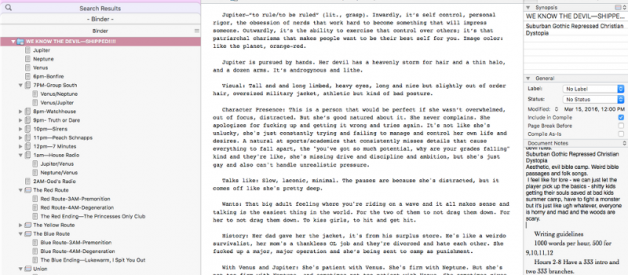Postmortem: 100 Days On We Know The Devil
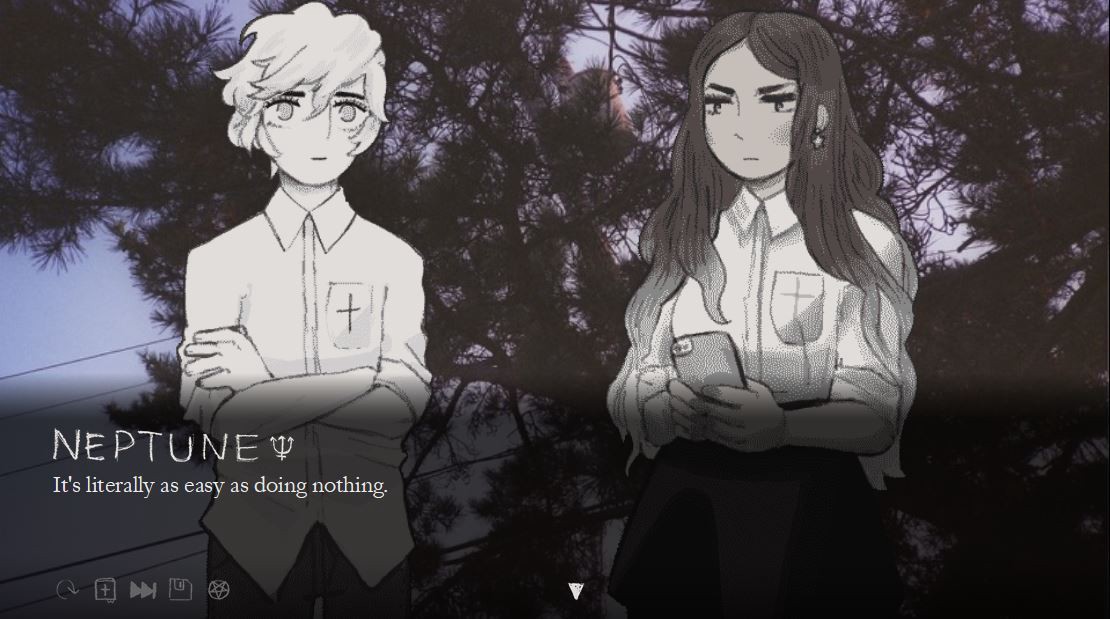
Linear prose is made to look seamless but it has structure and design, and so it?s possible that my claims about writing for games?that writing is design and vice versa?might be more surprising a claim about prose than games. What is radical about this claim for design is what it implies about how we treat writing as part of the design process, which is probably a bigger barrier to good writing in games than a lack of good writers (see: the treatment of narrative paramedics and writers who will hopefully do something).
The five act play, the action movie script, the detective novel, contemporary lit; these categories exist as categories because they have a structure, and the exceptions to existing structures are structured around their opposition (and eventually become their own genres). The visual novel, as a genre, has a lot of conventions (like being massively overwritten) but really the main thing is just that the writing is structured around a choices, which you can think of as the game mechanics if you?re into that sort of thing. Indie devs interested in making a concept for a game usually base their projects around seeing how much they can do with a single mechanic, and that?s actually how we wrote We Know The Devil: as the smallest implementation of a simple mechanic. We were able to figure out the structure and the word count of the project less than a week after deciding to do it, because we derived the structure from the mechanic, saw the scope of the project unfolding, and scaled it to something so reasonable that we actually had a chance of finishing it. This postmortem will go step by step for both how we came up with the initial idea, how we came up with the mechanic to implement that idea, how we came up with a structure around that mechanic, and how we came up with a word count and asset list from that structure. We were able to plan so tightly because it was such a small and simple project, and things still went way outside our expectations. Planning small gave us plenty of room to fuck up on our first commercial game project though, so I hope this will be helpful to you, too.
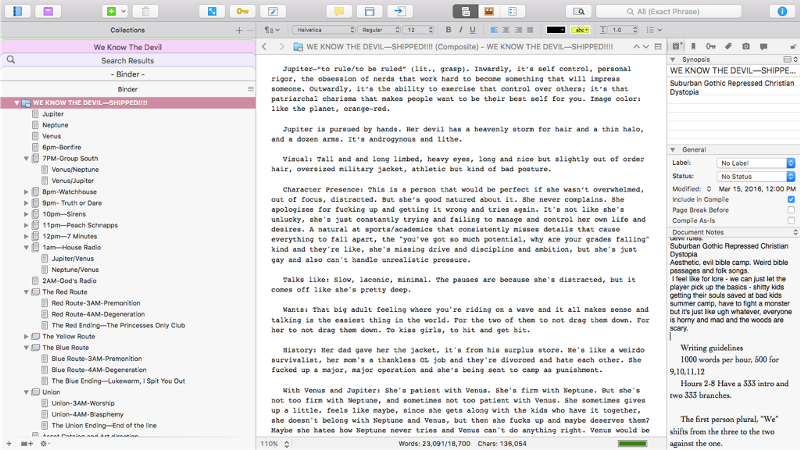 Screenshot of the finished script of We Know The Devil
Screenshot of the finished script of We Know The Devil
This is what We Know The Devil looked like to me until a few weeks before we shipped. I wrote the whole thing in Scrivener, and I definitely couldn?t have written it in anything other than Scrivener! I can?t overstate this enough so I hope you?ll really keep in mind that most of the structure and organizing I?m going to spend this postmortem talking about were possible because Scrivener had the tools for it. This is how I write anything at all longer than a single essay, regardless if it?s game, or not, nonlinear or not, because anything bigger than a single idea needs to be broken down into smaller pieces for me to hold onto the mess of it! So I?m going to go step by step for how we built the groundwork up from concept to characters to chapters to word count.
Pitching
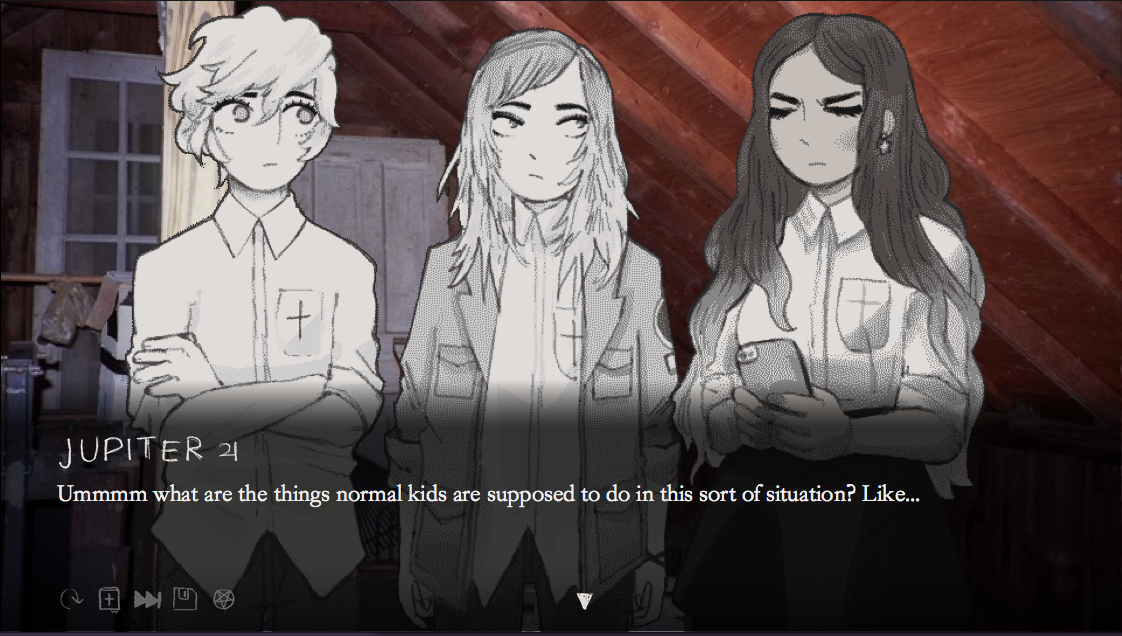
Mia Schwartz and I had been working on a big and ambitious project on and off for a year, and we were inspired by Amanda?s ILU game jam to make something small in a month. Mia felt strongly that she wanted the game to feel complete ? not a proof of concept or prologue or vertical slice. That sounded great to me because visual novels are so notorious long and overwritten the idea of a short story/novella length game felt really nice to me. So I told Mia about a handful of little ideas I had for small games that had a story seed and a mechanic I was interested in exploring. The idea of what became We Know The Devil was originally a tabletop RPG idea, actually ? but the core mechanic was ?let?s explore multiple characters interacting with each other? instead of a singular protagonist, with the tension hanging on on the risk of forcing one of those characters out. It was also the most fleshed out idea since I had both a premise for the fiction and a way of mechanically implementing it.
We Know The Devil is organized around the smallest implementation of a simple mechanic: for characters A, B, C, it is possible to choose a scene with two of these characters while leaving out the third, with a different ending for each of those possible sets. The math of it is the combinations of ABC; so AB, BC, and AC, but this is just the vocabulary we use to describe the experience of repressed young people seeking companionship, in much the same way that I described ?people? with the adjectives ?young? and ?repressed.? The math came right after the idea, and one of the first things that the math showed us was all combinations of ABC is less than all combinations of ABCD (AB AC BC AD DB DC). Because we both wanted to actually complete this game in a month, we cut the characters from my original pitch to Mia from four to three. The themes and images of sunday school and summer camp came with the initial pitch; to me they were inseparable from the whole premise. We watched a lot of horror movies and had a strong commitment to lo-fi aesthetics that would both fit the mood and our budget (preview: nearly all the worldbuilding in WKTD, including the radios, wouldn?t exist until the third draft).
Character Designing
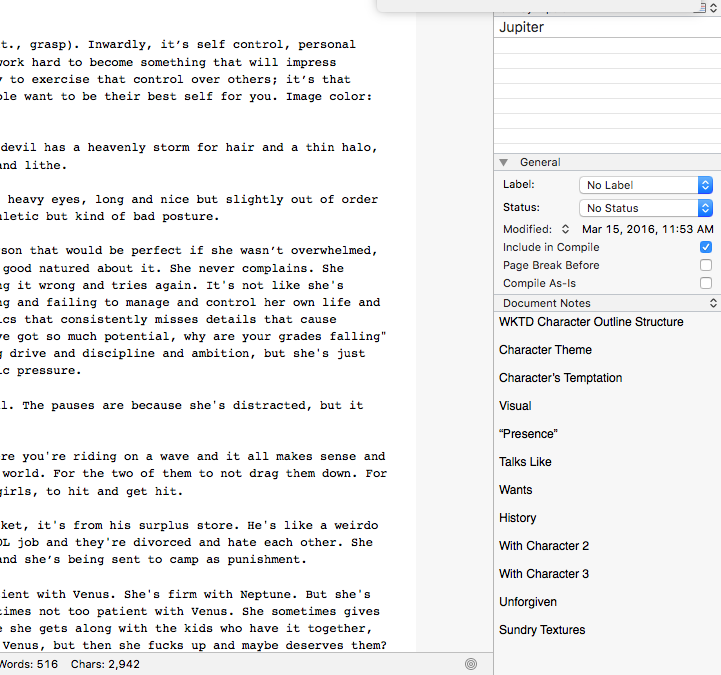 The template I used to create the initial character concepts before sending them to Mia
The template I used to create the initial character concepts before sending them to Mia
This is one of Mia and my favorite things, and it?s the reason this project came together. For a year we?ve been working on and off on a high concept game with lots of characters, and we had gotten used to bouncing ideas off of each other and collaborating ? I would write up character profiles, and then Mia would draw the characters. Mia works in comics and storytelling, which is part of why she is so good at capturing mood and expression with her art, and her creative choices and questions both built on my initial concepts and took the characters in exciting new directions. After we bounced concept art and character profiles we would both have such a grasp of the characters we could both write scenes featuring them; Mia would message me at like 12AM with ?this vine is totally Venus? and I?d be like, yes, and also the person who smashed the glass against her face is Neptune. We literally developed this game by shitposting with our own characters, so please value that work; it?s how we came up from everything from the underage drinking to the truth or dare and seven minutes in heaven scenes.
Structure
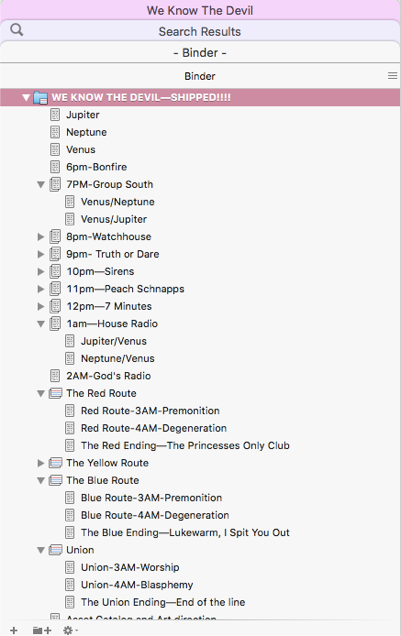
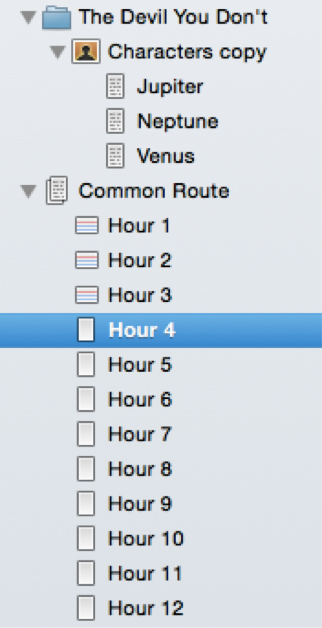 Left: Final scene list Right: Scene list on day six of development
Left: Final scene list Right: Scene list on day six of development
I asked for structure, and Mia thought that the course of a day would be the most logical, immediate, and teen-horror movie sort of premise. I moved it to a symmetrical 12 hour structure because this was shorter, and gave us a nice build up from evening to dawn.
Three characters meant three endings, meant three possible pairings of those characters. To make the scope of it even leaner, I decided that we?d only do two out of the three possible pairing for each choice. This would also mean that readers couldn?t pick the same option every time, and prevented readers from picking just whatever pairing was their favorite, and forced them to see what the other relationships were like. There were seven choices because an uneven number would mean you couldn?t get all of the pairings equally.
Obviously the first hour would be the introduction. There had to be a lead-in to the climax, so that would be hour nine. The endings were big enough that it felt like they deserved to take up three of those units, and it also let me divide the endings into rising action, climax, and resolution. The ending needs that moment right when you know everything?s going to collapse, and then the monster has to show up, of course! And finally, a moment of calm at the end. Again, the hour structure was arbitrary to this, but it helped me figure out what needed to go where. This same structure helped me a lot with creating parallels and distinct themes between the different routes.
Word Count
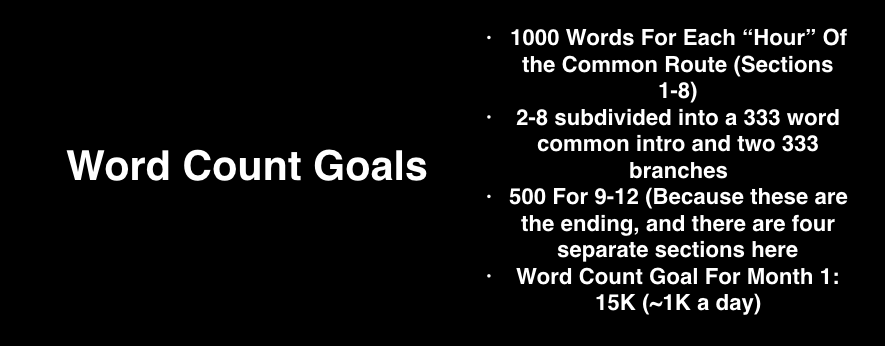
So there?s the technical breakdown! I hope it makes sense how we got from something very abstract and thematic to something more mathematical and crunchy as we specifically honed in what we both wanted to do and had the ability to do. It took all of that groundwork to give us this structure, but because of it, I knew I could sit down and write 1000 words each day, a thing that is easy to do if you know exactly what you?re doing, and incredibly hard if you have no idea where to start.
How To Write A VN In A Month: The Reality
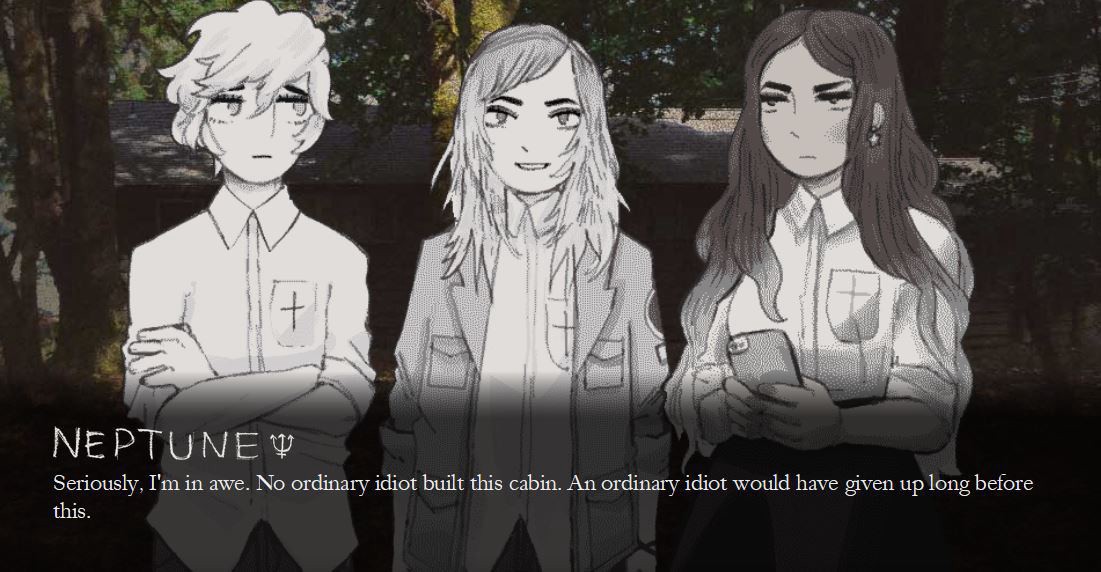
Anyone who has lived in reality for a length of time probably is aware that expectations do not frequently meet it! I was way short of all of my goals at the end of the month ? but I had done enough work that the skeleton of this structure was filled out, allowing me to have an immediate plan to address all of the shortcomings, and, just as importantly, it created a firmer outline of the work that the rest of the team needed to do as well, as first drafts of the scripts lead quickly to coming up with character sprite expressions, musical points, and programming scope.
The structure let us know what we did and what we still needed to do:
- Hold to the structure, and add in the last ending.
- Expand the word count, and also make the words good, not bad, because they were extremely bad.
- What was missing from the characters ? if their conflict or tension wasn?t working, or an importantly nuanced side of their personality hadn?t come up, it was time to look for how to bring it out.
- Run around in the woods in the dark and take photos
Premise and Mechanics
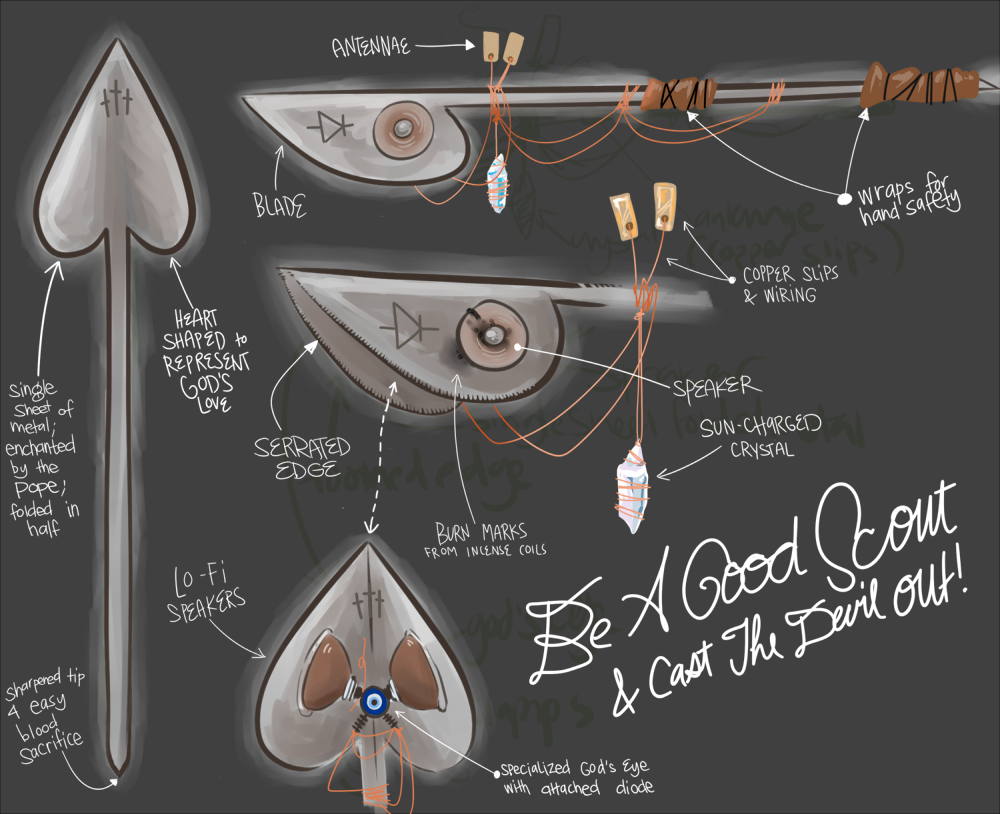 Designs by Fern of the radios; I love how differently everyone interpreted what they looked like.
Designs by Fern of the radios; I love how differently everyone interpreted what they looked like.
All of the worldbuilding in this game came after I had written the first draft, which may sound backwards in this era of exhaustive wikipedia based canons. These details though were all added in the second draft; I wanted to take the abstract ideas we had been swirling around and have a repeated image to anchor them. I felt like radios emphasized the backwards and out of time quality of the setting and evoked the religious radio stations I used to hear driving around in the midwest ? I looked up the history of old crystal radios you can make with just a rusted nail, which made them feel really strange and magical, tapping into something huge with ordinary household supplies.
Character Revisions
If their conflict or tension wasn?t working, or an importantly nuanced side of their personality hadn?t come up, it was time to look for how to bring it out. Mia didn?t always follow my exact visual designs, but that?s because she knows better than me! Mia looked first and foremost at bringing the character?s personalities out through their visual designs (like making Jupiter shorter to give her a cute contrast with Venus and Neptune).
What wasn?t okay was when the characters didn?t actually have tension or nuance! At Mia?s suggestion, I made Venus meaner ? it was hard to balance Venus being subtly cruel with wide eyed innocence, but I think I hit a balance strong enough that ppl reacted strongly? When characters didn?t have enough tension, something was wrong. Characters are defined by their actions in the final text, but to have an interesting final text, we had to make good on the promises we had made for ourselves. Though we outlined histories and backstory for all the characters, it just wasn?t needed anywhere in the final project. We thought about what might have shaped them, but once those personalities were in the game, the reader didn?t need to know them.
Structure and Wordcount in Practice
What do you do after you hit the word count goal? My favorite thing in the world is to hit delete, because I always write terribly when I write my first drafts, and the more I hit delete the closer I get to something I?m happy with. I hit my daily word count goals, but not always ? you can look at this math and think, why, she could have written a 30,000 word VN in a month in that case! But considering how much else was going on in my life, like a full time job, conferences, and being a functional adult (not to mention not starting until a week into the month) it was good to set the goals more conservatively.
I had a little room to grow for the second draft, but mostly, I had space to hit delete. Mostly in the second, but also in the third month, I was so grateful that I had the ability to take care making the script stronger rather than filling up files. In order to write some good words, you have to write a lot of bad ones.
Controlled Unpredictability
After this first month, though, I was really excited about what we had, and reached out to Jo and Conrad at DateNighto.com, which changed things a lot! But we wouldn?t have had that opportunity if we hadn?t also planned this so far in advance. I don?t want to give the impression that this came out of nowhere as much as it seemed, so even though this isn?t the focus and I don?t want to spend too much time talking about it, it?s important to note that even though neither Mia nor I had created video games outside of very small experimental projects, and this was by far our biggest and certainly first commercial game, we were both experienced and well connected artists in our field (I as a games writer and Mia as an indie comics artist/writer), which is how we were able to approach Date Nighto a month into development and suddenly have access to a programmer, project manager, and startup capital. We wouldn?t have have gone from nothing to character designs and first draft of the script in a month if Mia and I hadn?t been collaborating on an unpublished idea for the last year. That?s not to be intimidating, just to not be hard on yourself if you don?t have it yet! But to think about how important those skills are to develop alongside this sort of thing.
There?s so much more that went into making We Know The Devil, but I?m going to end it here, because this is the part of it that I know the best. I can definitely talk about scoring the game, inserting character expressions, last minute editing?but I?m going to keep this article focused on the writing work and planning. If you have any other questions, please ask me on Twitter!
